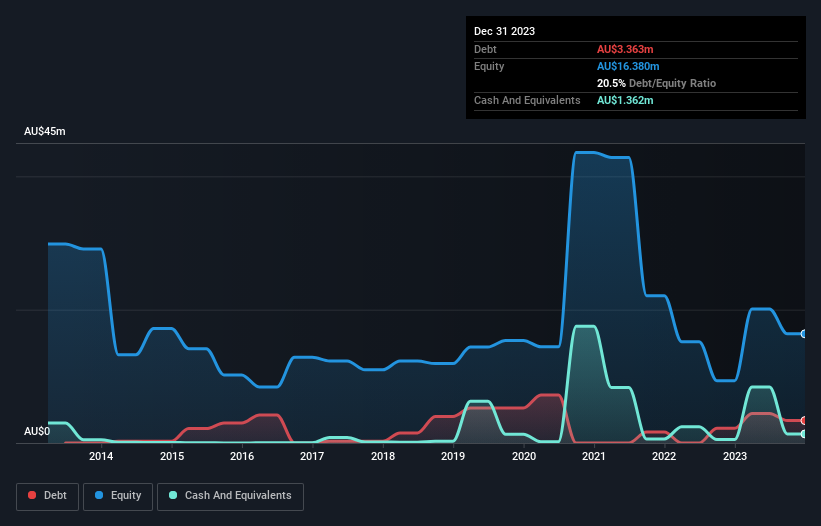
Warren Buffett famously said, 'Volatility is far from synonymous with risk.' It's only natural to consider a company's balance sheet when you examine how risky it is, since debt is often involved when a business collapses. We can see that Sihayo Gold Limited (ASX:SIH) does use debt in its business. But the real question is whether this debt is making the company risky.
When Is Debt Dangerous?
Debt is a tool to help businesses grow, but if a business is incapable of paying off its lenders, then it exists at their mercy. If things get really bad, the lenders can take control of the business. However, a more usual (but still expensive) situation is where a company must dilute shareholders at a cheap share price simply to get debt under control. Of course, plenty of companies use debt to fund growth, without any negative consequences. When we examine debt levels, we first consider both cash and debt levels, together.
View our latest analysis for Sihayo Gold
What Is Sihayo Gold's Debt?
As you can see below, at the end of December 2023, Sihayo Gold had AU$3.36m of debt, up from AU$2.21m a year ago. Click the image for more detail. However, it also had AU$1.36m in cash, and so its net debt is AU$2.00m.

How Strong Is Sihayo Gold's Balance Sheet?
We can see from the most recent balance sheet that Sihayo Gold had liabilities of AU$9.56m falling due within a year, and liabilities of AU$930.8k due beyond that. Offsetting this, it had AU$1.36m in cash and AU$92.5k in receivables that were due within 12 months. So its liabilities total AU$9.04m more than the combination of its cash and short-term receivables.
While this might seem like a lot, it is not so bad since Sihayo Gold has a market capitalization of AU$18.3m, and so it could probably strengthen its balance sheet by raising capital if it needed to. But we definitely want to keep our eyes open to indications that its debt is bringing too much risk. There's no doubt that we learn most about debt from the balance sheet. But you can't view debt in total isolation; since Sihayo Gold will need earnings to service that debt. So when considering debt, it's definitely worth looking at the earnings trend. Click here for an interactive snapshot.
Given its lack of meaningful operating revenue, investors are probably hoping that Sihayo Gold finds some valuable resources, before it runs out of money.
Caveat Emptor
Importantly, Sihayo Gold had an earnings before interest and tax (EBIT) loss over the last year. Indeed, it lost a very considerable AU$3.6m at the EBIT level. Considering that alongside the liabilities mentioned above does not give us much confidence that company should be using so much debt. Quite frankly we think the balance sheet is far from match-fit, although it could be improved with time. Another cause for caution is that is bled AU$8.8m in negative free cash flow over the last twelve months. So suffice it to say we consider the stock very risky. The balance sheet is clearly the area to focus on when you are analysing debt. But ultimately, every company can contain risks that exist outside of the balance sheet. For example, we've discovered 6 warning signs for Sihayo Gold (5 are significant!) that you should be aware of before investing here.
When all is said and done, sometimes its easier to focus on companies that don't even need debt. Readers can access a list of growth stocks with zero net debt 100% free, right now.
New: Manage All Your Stock Portfolios in One Place
We've created the ultimate portfolio companion for stock investors, and it's free.
• Connect an unlimited number of Portfolios and see your total in one currency
• Be alerted to new Warning Signs or Risks via email or mobile
• Track the Fair Value of your stocks
Have feedback on this article? Concerned about the content? Get in touch with us directly. Alternatively, email editorial-team (at) simplywallst.com.
This article by Simply Wall St is general in nature. We provide commentary based on historical data and analyst forecasts only using an unbiased methodology and our articles are not intended to be financial advice. It does not constitute a recommendation to buy or sell any stock, and does not take account of your objectives, or your financial situation. We aim to bring you long-term focused analysis driven by fundamental data. Note that our analysis may not factor in the latest price-sensitive company announcements or qualitative material. Simply Wall St has no position in any stocks mentioned.
About ASX:SIH
Sihayo Gold
Engages in the exploration and development of mineral resources primarily in Indonesia.
Moderate with mediocre balance sheet.
Market Insights
Community Narratives




